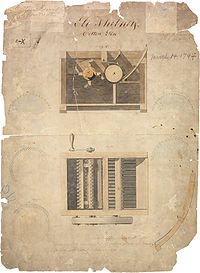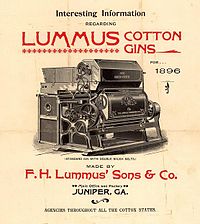- Cotton gin
-
 A cotton gin on display at the Eli Whitney Museum
A cotton gin on display at the Eli Whitney Museum
 "The First Cotton Gin", an engraving from Harper's Magazine, 1869. This carving depicts a roller gin, which preceded Eli Whitney's invention.[1]
"The First Cotton Gin", an engraving from Harper's Magazine, 1869. This carving depicts a roller gin, which preceded Eli Whitney's invention.[1]
A cotton gin (short for cotton engine)[2] is a machine that quickly and easily separates cotton fibers from their seeds, a job formerly performed by hand. The fibers are processed into cotton goods, and the seeds may be used to grow more cotton or to produce cottonseed oil; if they are badly damaged, they are disposed of. The first modern mechanical cotton gin was created by American inventor Eli Whitney in 1793 and patented in 1794. It used a combination of a wire screen and small wire hooks to pull the cotton through, while brushes continuously removed the loose cotton lint to prevent jams. Larger, more complex, automated cotton gins remain a crucial part of the cotton industry today.[3]
Contents
History
Early cotton gins
The earliest versions of the cotton gin consisted of a single roller made of iron or wood and a flat piece of stone or wood. Evidence for this type of gin has been found in Africa, Asia, and North America. The first documentation of the cotton gin by contemporary scholars is found in the fifth century AD, in the form of fifth-century Buddhist paintings depicting a single-roller gin in the Ajanta Caves in western India. These early gins were difficult to use and required a great deal of skill. A narrow single roller was necessary to expel the seeds from the cotton without crushing the seeds. The design was similar to that of a metate, which was used to grind grain. The early history of the cotton gin is ambiguous, because archeologists likely mistook the cotton gin's parts for other tools.[4]
Between the twelfth and fourteenth centuries, dual-roller gins appeared in India and China. The Indian version of the dual-roller gin was prevalent throughout the Mediterranean cotton trade by the sixteenth century. This mechanical device was, in some areas, driven by water power.[5]
Eli Whitney's patent
The modern mechanical cotton gin was invented in 1793 by Eli Whitney (1765-1825). Whitney applied for a patent on October 28, 1793; the patent was granted on March 14, 1794, but was not validated until 1807. There is slight controversy over whether the idea of the modern cotton gin and its constituent elements are correctly attributed to Eli Whitney. The popular image of Whitney inventing the cotton gin is attributed to an article on the subject written in the early 1870s and later reprinted in 1910 in The Library of Southern Literature. In this article, the author claimed that Catherine Littlefield Greene suggested to Whitney the use of a brush-like component instrumental in separating out the seeds and cotton. To date, there has been no independent verification of Greene's role in the invention of the gin.
Many contemporary inventors attempted to develop a design that would process short staple cotton, and Hodgen Holmes, Robert Watkins, William Longstreet, and John Murray had all been issued patents for improvements to the cotton gin by 1796.[6] However, the evidence indicates that Whitney did invent the saw gin, for which he is famous. Although he spent many years in court attempting to enforce his patent against planters who made unauthorized copies, a change in patent law ultimately made his claim legally enforceable — too late for him to make much money off of the device in the single year remaining before the patent expired.[7]
Whitney's design
Whitney's cotton gin model was capable of cleaning 50 pounds (23 kg) of lint per day. The model consisted of a wooden cylinder surrounded by rows of slender spikes, which pulled the lint through the bars of a comb-like grid.[8] The grids were closely spaced, preventing the seeds from passing through.
Effects of the cotton gin
Prior to the introduction of the mechanical cotton gin, cotton had required considerable labor to clean and separate the fibers from the seeds.[9] With Eli Whitney’s introduction of “teeth” in his cotton gin to comb out the cotton and separate the seeds, cotton became a tremendously profitable business, creating many fortunes in the Antebellum South. New Orleans and Galveston were shipping points that derived substantial economic benefit from cotton raised throughout the South. Additionally, the greatly expanded supply of cotton created strong demand for textile machinery and improved machine designs that replaced wooden parts with metal. This led to the invention of many machine tools in the early 19th century.[10]
The invention of the cotton gin caused massive growth in the production of cotton in the United States, concentrated mostly in the South. Cotton production expanded from 750,000 bales in 1830 to 2.85 million bales in 1850. As a result, the South became even more dependent on plantations and slavery, with plantation agriculture becoming the largest sector of the Southern economy.[11] The number of slaves rose in concert with the increase in cotton production, increasing from around 700,000 in 1790 to around 3.2 million in 1850.[12] By 1860, the southern states were providing two-thirds of the world’s supply of cotton, and up to eighty percent of the crucial British market.[13]
According to the Eli Whitney Museum site:
Whitney (who died in 1825) could not have foreseen the ways in which his invention would change society for the worse. The most significant of these was the growth of slavery. While it was true that the cotton gin reduced the labor of removing seeds, it did not reduce the need for slaves to grow and pick the cotton. In fact, the opposite occurred. Cotton growing became so profitable for the planters that it greatly increased their demand for both land and slave labor. In 1790 there were six slave states; in 1860 there were 15. From 1790 until Congress banned the importation of slaves from Africa in 1808, Southerners imported 80,000 Africans. By 1860 approximately one in three Southerners was a slave.[14]
Due to its inadvertent effect on American slavery, the invention of the cotton gin is frequently cited as one of the ultimate causes of the American Civil War.[15][16][17]
Modern cotton gins
In modern cotton production, cotton arrives at cotton gins either in trailers or in compressed "modules", which weigh up to ten metric tons each. The need for trailers to haul the product to the gin has been drastically reduced since the introduction of the module. Cotton arriving in trailers is sucked into the gin via a pipe, approximately 16 inches in diameter, that is swung over the cotton. This pipe is usually manually operated, but is increasingly automated in modern cotton plants. If the cotton is shipped in modules, the module feeder breaks the modules apart using spiked rollers and extracts foreign material from the cotton. The module feeder's loose cotton is then sucked into the same starting point as the trailer cotton.
The cotton then enters a dryer, which removes excess moisture. The cylinder cleaner uses six or seven rotating spiked cylinders to break up large clumps of cotton. Finer foreign material, such as dirt and leaves, passes through rods or screens for removal. The stick machine uses centrifugal force to remove larger foreign matter, such as sticks and burrs, while the cotton is held by rapidly rotating saw cylinders.
The gin stand uses the teeth of rotating saws to pull the cotton through a series of "ginning ribs", which pull the fibers from the seeds which are too small to pass through the ribs. The cleaned seed is then removed from the gin via an auger system. The seed is reused for planting or is sent to an oil mill to be further processed into usable items. The lint cleaners again use saws and grid bars, this time to separate immature seeds and any remaining foreign matter from the fibers. The bale press then compresses the cotton into bales for storage and shipping. Modern gins can process up to 15 tonnes (33,000 lb) of cotton an hour.[3]
References
- ^ Lakwete, 182.
- ^ Merriam-Webster Dictionary
- ^ a b "Background on the Cotton Gin". About.com. Retrieved 2011-10-22.
- ^ Lakwete, 1-6.
- ^ Baber, page 57
- ^ Lakwete, 64-76.
- ^ The American Historical Review by Henry Eldridge Bourne, Robert Livingston Schuyler Editors: 1895–July 1928; J.F. Jameson and others.; Oct. 1928–Apr. 1936, H.E. Bourne and others; July 1936–Apr. 1941, R.L. Schuyler and others; July 1941– G.S. Ford and others. Published 1991, American Historical Association [etc.], pp 90–101.
- ^ M E Harr. (1977). "Mechanics of particulate media; A probabilistic approach". McGraw-Hill.
- ^ Hamner, Christopher. "The Disaster of Innovation." Teachinghistory.org. Accessed 11 July 2011.
- ^ Roe, Joseph Wickham (1916), English and American Tool Builders, New Haven, Connecticut, USA: Yale University Press, LCCN 16-011753, http://books.google.com/books?id=X-EJAAAAIAAJ&printsec=titlepage. Reprinted by McGraw-Hill, New York and London, 1926 (LCCN 27-024075); and by Lindsay Publications, Inc., Bradley, IL, USA (ISBN 978-0-917914-73-7).
- ^ Pierson, 25.
- ^ Smith, 82.
- ^ Cotton--a history, 19.
- ^ http://www.eliwhitney.org/museum/eli-whitney/cotton-gin Creative Commons Attribution-Noncommercial
- ^ Martin Kelly, "Top Five Causes of the Civil War: Leading up to Secession and the Civil War (Reason No. 1), About.com; accessed 2011.03.14.
- ^ Joe Ryan, What Caused the American Civil War?. Accessed 2011.03.14.
- ^ Randy Golden, "Causes of the Civil War". About North Georgia. Accessed 2011.03.14.
Bibliography
- American Historical Association. "Correspondence of Eli Whitney Relative to the Invention of the Cotton Gin". The American Historical Review, October 1897, Vol. 3, Is. 1, p. 90-127.
- Baber, Zaheer. The Science of Empire: Scientific Knowledge, Civilization, and Colonial Rule in India. Albany: State University of New York Press, 1996. ISBN 0791429199.
- "Cotton--a history". New Internationalist. April 2007, Is. 399, p. 18-19.
- Lakwete, Angela. Inventing the Cotton Gin: Machine and Myth in Antebellum America. Baltimore: The Johns Hopkins University Press, 2003.
- Philips, William H. "Cotton Gin". Economic History Association
- Parke Pierson. "Seeds of conflict". America's Civil War, September 2009, Vol. 22, Is. 4, p. 25.
- Smith, N. Jeremy. "Making Cotton King". World Trade. July 2009, Vol. 22, Is. 7, p. 82.
External links
- Overview of a Cotton Gin - USDA site
- The Story of Cotton - National Cotton Council of America site
- National Cotton Ginners Association
- US Cotton Gin Industry (EH.Net Encyclopedia of Economic History)
- Invention of Cotton Gin - eHistory.com
- Cotton: the fiber of life includes a schematic diagram illustrating the seed removal process
- Video of manual cotton gin in operation
Categories:- Agricultural machinery
- 1793 introductions
- History of the textile industry
- Cotton
- American inventions
Wikimedia Foundation. 2010.



